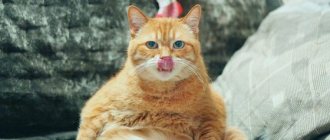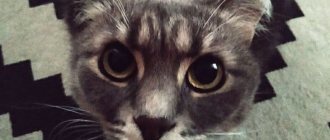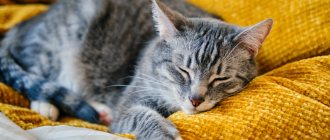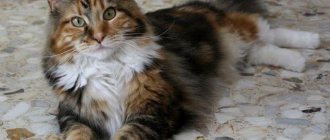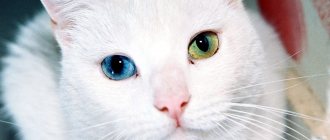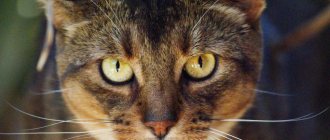Features of cat behavior
Since ancient times, cats have lived alongside humans as pets. They were either revered as a deity, or exterminated as accomplices of the devil. The point is in their behavior, which is often incomprehensible to humans.
When it comes to keeping and caring for a cat, it is perhaps the most unpretentious animal. She does not need to be walked, unlike a dog, she does not litter like a rodent or a feathered pet. But it is almost impossible to train a cat.
If you try, she can do a couple of tricks, but she will perceive training as an exciting game, and not as obedience. There are legends about the waywardness of cats. Therefore, the cat perceives direct gaze as an invasion of its personal space and may react in different ways.
How cats are treated in other countries
In ancient Egypt, the goddess Bastet was revered, who had two incarnations: a woman with the head of a cat and a woman with the head of a lion. They supposedly exist on the border of two worlds: the human world and the afterlife. The good incarnation is the patroness of love, the hearth, and a symbol of fertility. And a woman with the head of a lion is an evil and aggressive embodiment that can destroy a person.
Goddess Bastet in the form of a cat
The ancient Egyptians considered the cat to be the earth's equivalent of the moon. And if you look closely into the eyes of the goddess Bastet, this will be a sign of extreme disrespect for the moon and the sacred gods. Because of this, an unwary person can end up in the afterlife and remain there forever.
Goddess Bastet in the guise of a lioness
Cats are very curious creatures. Being in the apartment for a long time, they watch their household for a long time, happily accepting affection and kind attitude. Ancient signs do not mean that they are associated with evil.
Modern science explains in detail the features of their vision, which were incomprehensible to ancient people and frightened them. These sciences help owners find the right approach to their pets: shaggy Persians, long-haired Maine Coons, hairless Sphynxes.
According to scientists, there are about 400 million domestic cats living on the planet. Americans have the most of these animals. But Australia ranks first in the number of tailed households. In this country, every 10 people keep 9 cats.
Among Asian countries, Indonesia ranks first. There are more than 30 million cats in this country for 270 million inhabitants.
For a long time, cats had a hard time in Vietnam, where these animals were eaten. However, when countless mice bred in this country, destroying grain and rice, the country's president ordered the closure of restaurants serving cat meat.
France is also cruel to cats. In France there is a law according to which a kitten that has not been purchased within a month is of no use to anyone and is euthanized. In Belgium, on the contrary, there is a special holiday for pets. On this day, carnivals, dances are held, and performances featuring black cats and puss in boots are shown.
The Muslim religion does not like dogs, but respects cats. The prophet Magomed himself adored them. He even added the title of father of cats to his many titles.
Cat's "look language"
Carefully observing a cat, you can notice that, like a person’s, its gaze is very expressive and conveys a lot of emotions:
- Hunting;
- Excitation;
- Relaxation;
- Dominance;
- Aggression;
- Confidence.
To better understand a cat’s behavior, you need to observe not only its gaze, but also its overall posture and behavior.
"Hunting". Many owners have observed how a cat's eyes widen funny when you attract it with a toy. The animal presses to the floor and moves its tail. This is a signal of attack and hunting. At this time, the cat is not afraid - she is hunting.
- Excitement – many cat owners have noticed how the cat’s pupils sharply constrict at the sound or rustling of a bag of food. This is a sign of strong emotions: fear, anger.
- Dominance - if a cat sits or lies close to the owner and watches his movements, almost without blinking, she is “in control.” Under natural conditions, this behavior can go either into a state of relaxation or into an attack. At home, a cat's behavior depends on its degree of trust in its owner.
- Aggression – Aggressive behavior is almost unusual for domestic cats. But if she presses her ears to her head, beats her tail and narrows her eyes, it means she will attack.
- Trust – often, the cat lies relaxed, but at the same time its eyes are wide open, the pupil is dilated, and the animal blinks slowly. If a cat does not cover its eyes when communicating with its owner, this is the highest degree of trust. In the wild, animals often squint to protect their eyes.
- An indicator of the closest understanding between the owner and the cat is the look called the “cat kiss.” When the cat is relaxed and lying down with slightly squinted eyes, look into her eyes and blink slowly. If the cat behaves the same way, this is a sign of complete mutual understanding.
If the cat itself tries to look into the eyes of its owner, it means it is hungry or requires attention.
Perhaps the cat wants to tell you something?
A word from Dr. Kathryn Primm: “Cats appear to be wired for nonverbal communication with people. Looking at its owners, the cat seems to ask for help in understanding the correctness of this or that choice, probes for a possible reaction and at the same time shows what it itself needs from them. The cat carefully reads human eyes and studies body language. Perhaps she herself “says” something at the same time. She really needs to see the owner's reaction, since she actually considers herself part of the family. It is very important to respond to your pet with exactly the same piercing gaze. By doing this, you calm the animal, assure it of some kind of social stability, and instill a sense of confidence. A calm owner means a calm cat. If you move your gaze somewhere else, your mustache will do the same.”
A cat's gaze is a kind of declaration of love, if you will. The next time you catch a “prickly” and “unblinking” look on yourself, return it to your pet. And as if by accident, blink at the same time. May love live long in your home!
source https://ilike.pet/ru/articles/koshka-sverlit-vas-vzglyadom-chto-eto-znachit_19/
Why is the game of staring contest dangerous?
Many have seen cat fights. Opponents arch their backs, growl or howl at each other, and make intense eye contact.
- For cats, a direct gaze is a sign that the enemy is about to attack.
- Since any person is many times larger than a cat, the animal is simply afraid of direct gaze.
Out of fear, a cat can attack, aiming for the face as the most unprotected part of the body. This is why you shouldn't look a cat in the eye.
Not scary yet?
Have you ever caught a cat's gaze, unblinking, on you? The author has no doubt - they caught him, and more than once. And you even shrank from the prickly and hypnotic gaze of your pet; you probably felt uneasy. Another cat oddity? So be it.
It is not for nothing that the mustachioed-striped ones are represented as magicians and wizards in folklore all over the world. Even if you are not into mysticism and are an inveterate materialist, you will admit that there is something alien in a cat’s gaze that cannot be explained. What does a cat's eye actually mean? Do pets look at people and other cats the same? Let's figure it out.
Reaction and character
Experts believe that it is almost impossible to predict what will happen if you look into a cat’s eyes. This largely depends on the nature of the pet and the conditions under which it is kept.
If a cat trusts people, is not offended, and feels safe, then the pet can withstand the direct gaze of even a stranger.
- More often than not, animals, and not just cats, are the first to look away.
- If a cat looks intently into the eyes of a random guest, you should not trust such a person.
- These animals sense non-verbal signs of insincere behavior very well and try to drive the “enemy” out of their territory.
What to do
If your cat's staring is bothering you, the only way to stop it is to find out what's causing it. Once you understand what's behind the behavior, you can give your cat what she wants and end the problem once and for all.
Of course, there may not be a single reason. One day your cat may be looking at you for one reason and the next day looking at you for a completely different reason. You'll just need to use context clues to figure out what your kitty wants.
Either that, or you can live being stared at like a regular celebrity. It's your choice.
Posted by Christian Adams An American expat living in Metro Manila, Philippines for over a decade, Christian is a lifelong cat lover and the proud father of two rescue cats, Trixie and Chloe. Both girls used to be among the crowds of homeless people who roam the cities and countryside. Three-year-old Trixie was rescued from a litter found under a neighbor's porch, and two-year-old Chloe was brought home by Christian's young son, Henry, who discovered the crying kitten in the parking lot.
Signs and beliefs about cats
Many signs have developed as a way to convey safety rules in accessible language without explanation. The notorious sign about “a black cat crossing the road” was born during the Tatar-Mongol yoke.
If a cat crossed the road not far from the village, it means that the animal was left without a home and the village was ruined. Well, they “painted” it black to make it even more intimidating.
Protecting children from injuries that a cat can cause, older family members answer the question “Is it possible to look cats in the eyes?” They responded with a categorical ban, intimidating that “the cat will steal your soul.”
- The sign that if a cat looks into its eyes for a long time, the person will soon die also has a completely scientific explanation.
- Cats and dogs notice signs of illness faster than people, and since the cat's owner is a source of food, it thus expresses its concern.
- Observant people soon noticed that the cat was looking intently into the eyes - the man was dying. And they made the wrong conclusions, confusing cause and effect.
Even with a rational and strictly scientific approach, some features of cat behavior are quite difficult to explain.
Why you shouldn't look into your cat's eyes for too long
If you've seen any wildlife documentaries, you know that most animals perceive direct gaze as a prelude to an attack. Suspecting a threat emanating from the owner's fixed gaze, the pet can scratch him by waving his paw in the face. Close observation of a cat will inevitably make her dislike and want to show hostility.
Main reasons
For a long time, people have tried to understand why an affectionate domestic animal suddenly becomes angry or suddenly changes its behavior if it is looked at closely. The first explanation for this oddity lies in the predatory instinct inherited from wild ancestors. With their gaze, cats not only try to intimidate the victim, but also to show superiority over the enemy . It is important for them to be a winner, a master of the situation. That's why they try to attack first.
More than once I had to watch how two cats sort things out in a common territory. Having met, they stop, nervously twitching their tails. Then each shows his strength with a low guttural howl, more like a growl, and tries to intimidate his opponent with a persistent gaze. The visual “intimidation” lasts for several minutes. The eyelids do not blink. And so the weaker or insecure male lowers his eyes. With this he admits his defeat. Sometimes it is not possible to identify the leader in this way and a fight begins, where the claws become the main argument.
The second explanation is that the animal’s sense of self-defense from possible danger is triggered. Here, the way in which he decides to fight for his life will depend on the character and temperament of the mustachioed animal. In the cat’s mind, a person is a huge creature, but she will not allow him to offend her either. A furry pet may not show open aggression, but may take revenge quietly: chew off shoes, poop away from the litter box, or tear a curtain. The owner does not always realize that the dirty trick was done intentionally.
Advice: if you feel that your close examination of the cat has provoked her anger, do not look away. First, blink, sneeze quietly, and only then look to the side. Or turn away and demonstratively take some object in your hand, showing that you didn’t want a conflict.
The mysticism of a cat's gaze
There is no person who would not pay attention to the deep, mysterious gaze of round eyes on a fluffy face. It gives a mystical impression. In the myths and legends of most peoples of the world, the cat acts as a protector from evil, a guardian of the underworld. Her ability to see in the darkness of the night gave rise to beliefs in communication with the souls of the dead. The brave animal freely enters the afterlife and returns to the living. At the same time, he communicates with ghosts and other evil spirits.
In Ancient Russia they believed that the long gaze of a strange cat casts spells on people . A child could become seriously ill, while an adult would lose money, livestock would die, resulting in poverty. In contrast, it was believed that the mouser living in the hut could see the brownie and liked to play with him at night.
The meaningful expression of a cat's gaze gave rise to legends about its magical properties
During the time of the Egyptian pharaohs, people noticed that the eyes of cats had hypnotic properties. The source of this opinion was the behavior of mustachioed hunters, who kill poisonous snakes with dexterity. But even now there are owners who claim that their pets have the gift of suggestion.
One friend told me how her wayward furry miracle with a penetrating gaze gets a tasty morsel from the master’s table. Requires only meat, ignoring lean dishes. When the family starts dinner, the cat silently sits down on the floor and begins to “drill” into one of the household members with its eyes. I can’t believe it, but he won’t be able to swallow even a spoon until he cuts off a slice of boiled beef for the “extortionist.” After this, any person recognizes the animal’s ability to hypnosis, discarding thoughts of a simple coincidence.
Video: the origin of superstitions about the secrets of a cat's gaze
Scientific explanation
Many centuries ago, people were afraid of cat's eyes glowing in the twilight, not understanding the reasons for this phenomenon. Now veterinary ophthalmology knows the answer to this question. It turns out that the vision of furry pets is adapted to hunting at night using the effect of back radiation . At the back of the eyeball there is a special layer of cells with a luminescent pigment that can reflect light. Once inside the retina, small glimpses are magnified many times over, as if in a mirror. Then we see the shining dilated pupils of the mustachioed pet.
It is this mechanism that helps the cat recognize objects in the dark. The amount of pigment on the bottom of the eye varies depending on the breed. During the day, the animal’s clarity of vision is worse than in the evening. But the ability to quickly concentrate your gaze on moving objects works equally well at any time of the day. This is typical for predators waiting for prey in ambush.
The glow of cat's eyes in the dark depends on the color and amount of pigment in which they are painted.
Mysticism and cats
Esotericists are sure that cats feel a person on an energetic level. You can believe it or not, but how can you explain that lost cats travel many kilometers and return home?
- Scientists still cannot explain why a purring cat significantly alleviates the condition of a sick person.
- Cats have a beneficial effect on the cardiovascular system of their owners. Their owners are much less likely to suffer from heart attacks and strokes.
- If a pet tries to lie down in a certain place and stares intently into the eyes, the owner has a reason to visit a doctor.
The cat feels the negative energy of the sore spot and tries to compensate for it.
Love your cat, win her trust and then you will understand each other at a glance.
My cat looks at me when I sleep
Cats are curious and alert animals, so almost any change in their environment can attract their attention. This is often why they will. follow you around the house as they become interested in what you are doing. Cooking, doing homework, and even sleeping can be a mystery to your cat. These riddles become a fascination and watching you is their way of pampering them.
Additionally, if your cat joins you at bedtime or nap time , they may look at you in a special way. It usually blinks lazily at you. If this happens, then congratulations are in order. Your cat trusts you and feels comfortable enough to allow himself to be vulnerable around you.
This gesture is common when they curl up to sleep with you or when you pet them. The cat wants you to know that they are feeling relaxed, as they will only allow this to happen to those who feel most comfortable. Simply put, your cat loves you!
